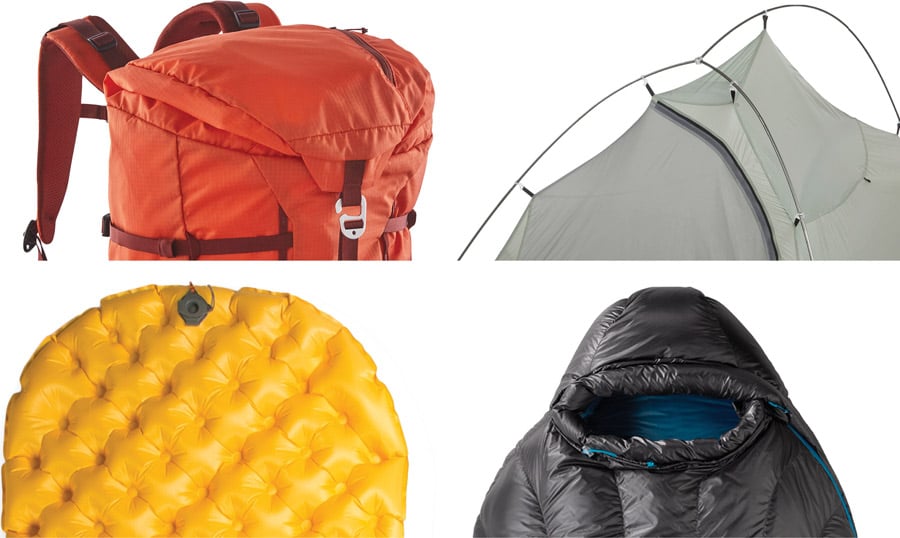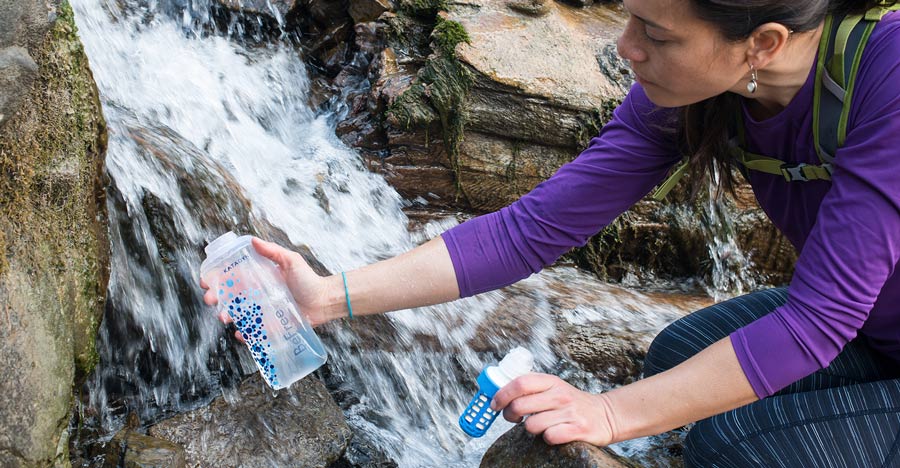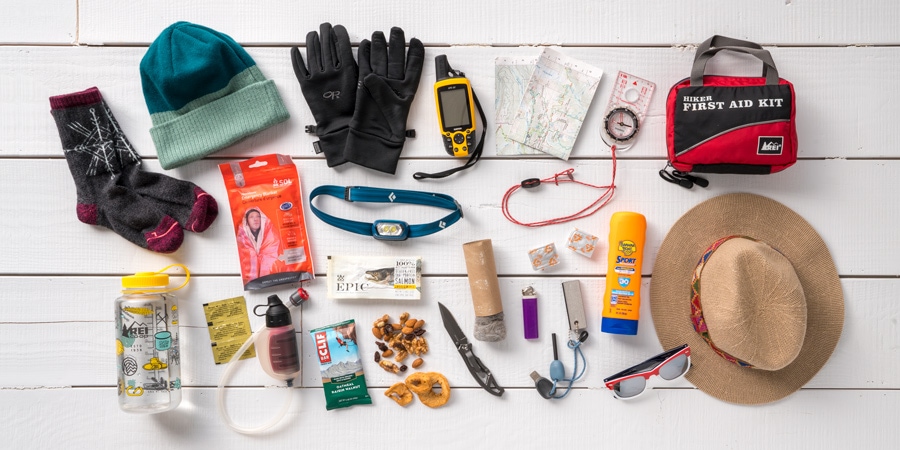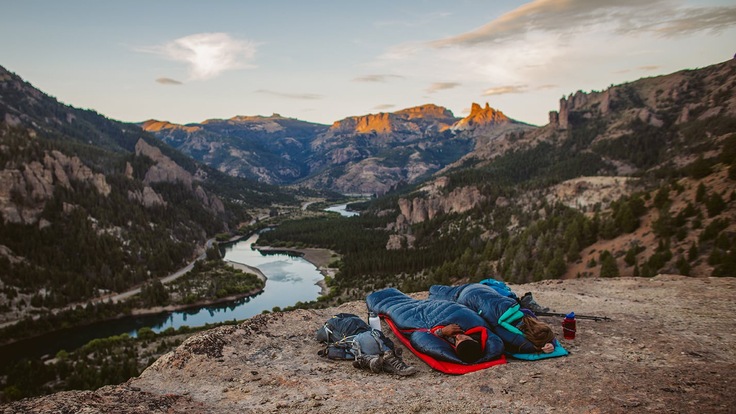John Muir took little more than bread and tea into the wilderness. By the 1960s, a century later, backpackers were carrying up to 50 or even 70 pounds' worth of gear. In the 1990s, the mindset began to change and modern materials have swung the pendulum back to the "less is more" philosophy.
So, what is ultralight backpacking? No official definition of "ultralight" exists. It's more a frame of mind than an arbitrary pack weight. It's about deciding you can get by with less. You can find your own sweet spot on a continuum of, say, 12 to 28 pounds. Relying less on gear means relying more on your own judgment of how to stay safe, healthy and comfortable on the trail.
If you're ready to lighten your load on the trail, here are a few tips for starters:
- Weigh your gear: Find a kitchen and/or luggage scale and weigh your current gear. Make a note of your current "base weight": everything on your back except food, water and fuel (known as consumables).
- Replace older gear with lighter gear: As you replace old gear and choose new gear, pay close attention to each item's weight. You'll be aiming for a total base weight of about 10 pounds. (Once you add consumables that weight may double.)
- Make gradual changes: Because gear can be more expensive the lighter it gets, a smart approach may be to lessen your load over time. Replace one "big ticket" item at a time with a lighter-weight (and potentially more costly) model.
- Understand the tradeoffs: Sewing your own pack and other gear, as many do, is a great way to go lighter and save money. Keep in mind that while lighter in weight, ultralight gear may not be as durable or as comfortable in the long run as conventional gear.
The following additional suggestions and our Ultralight Backpacking Checklist will help you decide where to start cutting.
Video: Ultralight Backpacking Tips
Going Ultralight With The Big Four

The fastest way to lighten your load is to replace one or all of the four largest items most backpackers carry: pack, tent, sleeping bag and pad.
Backpack
While a traditional backpacker might have a 65-liter pack in the three- to four-pound range, savvy ultralight devotees may choose a frameless, minimally-padded 45- to 55-liter pack, occasionally even smaller, weighing a scant one-and-a-half to two pounds.
Shelter
Tents: If you prefer the cozy feel of a tent, choose a full-mesh tent (with rainfly) to keep out insects and other small critters. You can find an ultralight one-person tent (using a trekking pole for support) at around one pound; two pounds is more common. (Learn more at Backpacking Tents: How to Choose.)
Tarps: You can create a decent rain shelter out of an ultralight tarp. It may require guylines and a couple trees, stakes or trekking poles for support.
Bivy sacks: These generally weigh between one and two pounds for a waterproof shell; a bare-minimum bag may weigh about six ounces.
Ultralight hammocks, which may include a bug net or rainfly, are also becoming a popular choice.
Sleeping bag
Choose down—it's lighter and more compressible than synthetic fill. Most down now is treated to be water-resistant. You can find a down bag weighing one or two pounds.
To lower your bag weight:
- Choose a bag no warmer than you really need. Extra warmth just means extra weight.
- Choose a mummy bag without a hood; wear a balaclava and/or warm knit hat on cold nights.
- Consider a down trekking quilt (becoming popular with thru-hikers) instead of a sleeping bag.
Learn more at Sleeping Bags for Backpacking: How to Choose.
Sleeping pad
Air pads have replaced self-inflating pads as the lightest comfort pads for backpacking. For under one pound you can get a full-length pad that offers a lot of cushioning and even a little insulation. Thru-hikers, however, still typically prefer a closed-cell foam pad for their greater durability over the long haul.
To save ounces, choose a torso-length pad, or you can cut down a closed-cell foam pad. You can use your pack under your feet for insulation from the ground, but here's where your comfort decision comes into play.
Learn more at Sleeping Pads: How to Choose.
Water, Fuel and Food

After the big four, these are your heaviest items. Learn to carry only as much as you need for the length of time you'll be on the trail.
Water
You don't need to carry all the water you'll need for the entire day. Do your research and find out where streams and lakes are found along your route so you can filter and refill along the way. Some tips:
- "Camel up" before you leave camp each morning by drinking a good amount of water. Do the same each time you reach a water source (after you filter, of course). This way you may find you can get by with carrying less water as you hike.
- Carry only one liter (2.2 pounds) if that seems feasible (unless you're in a desert, then you'll need more) between water sources.
- Carry a mini filter (some weigh only two ounces) and some backup purification tablets (in a tiny plastic bag, not the glass bottle they may come in).
- Use collapsible water bottles (One- to two-liter capacity). A soft bottle is 80 percent lighter than a hard-plastic water bottle.
Fuel, Stove and Cookware
To stay light, plan to simply boil water to add to dehydrated food instead of cooking a meal from scratch. This saves weight both on the food and the fuel. Regarding cookware, think dual-purpose: a titanium mug can also serve as a pot. Bring a spork instead of a spoon and a fork.
Popular ultralight stove options:
- Tablet fuel stoves: You can make the stove out of an aluminum can or buy one, and bring a tablet of fuel per day or per meal, as you figure out your needs.
- Alcohol stove: Weighs a mere ounce. Bring a bottle containing only as many fluid ounces of alcohol as you'll need per meal per person per day. Make sure the bottle is sturdy enough not to puncture or break inside your pack (keep it inside a zip-top bag just in case).
- Canister stove: These tiny folding stoves may weigh only two- to three ounces. However, they screw onto isobutane canisters that weigh quite a bit. Learn through practice how many meals you can get out of one canister. A rule of thumb is two ounces per day (that's enough for one person eating two meals each day).
- Integrated canister stove system: Yes, some ultralight backpackers will bring one of these, especially for two or more people. While heavier, this system boils water very quickly so you may save weight by bringing less fuel.
Learn more at Backpacking Stoves: How to Choose.
Food
Plan on bringing enough food to give you 3,000 to 4,000 calories per day, or about two pounds of food per day, depending on how many miles you cover and how fast, and how strenuous the elevation gain/loss is.
Some ultralight food tips:
- Go instant: For breakfast, instant coffee and instant oatmeal are quick and fuel-efficient. On cold mornings, eat a protein bar to get up and moving in the morning; stop later along the trail for your oatmeal.
- Be calorie conscious: Bring fat- and calorie-rich snacks for lunch: protein bars, nuts, seeds, chocolate, dried fruit, powder supplements, and if you don't mind the weight, some hard cheese and salami.
- Dehydrate your own food at home: This saves money and packaging, plus you get to create and season meals the way you like.
- Do your own packaging: Store each dried dinner in a zip-top freezer bag and add your hot water directly to it (the bag can withstand near-boiling water).
- Rehydrate some foods using cold water and letting sit for an hour or two; this saves fuel.
- Use what you find, first: If you do eat out of a mug or pot and need to clean it beyond a mere rinse, use leaves, sand or grass to wipe out the vessel first. Then use a bit of water and scrub if necessary with a one-by-two-inch piece of sponge (cut from a larger one at home).
Learn more in our article about meal planning for backpacking.
Additional Ultralight Backpacking Tips

Don't skimp on safety: As you lower weight, keep in mind that every time you step into the backcountry, you should pack the Ten Essentials. While it's smart to pack light, it's equally smart to pack safely.
Navigation system: Bring a map, compass, and a GPS watch or device. Learn about the pros and cons of a personal locator beacon with satellite messaging. These are heavy, but can give you (and your loved ones at home) peace of mind knowing you can send "I'm fine" messages or summon help.
Safety whistle: A lightweight yet loud whistle can be worn around your neck so it's ready to use in an emergency. Three blasts is the international distress call for help.
Sun protection: Bring a few ounces of sunscreen in a small bottle and a tube of lip balm rated UPF 30. A good sun-shading hat is your first line of defense. In the desert, consider hiking in sun gloves and a UPF 50+ long-sleeve shirt. Sunglasses are a necessity for good eye health.
Illumination: Find a no-frills, low-weight kids' or adult headlamp weighing two or three ounces including batteries. Put in fresh batteries right before you leave home so you don't have to bring extras (depending on length of trip). You can even light up your camp with a small LED lantern that weighs 2.5 ounces including its single AA battery. To go truly minimalist, use only tiny LED microlights that weigh 0.5 ounce.
Insulation and clothing: Always carry a lightweight down or synthetic puffy jacket. For base layers, you'll want long underwear bottoms and usually a long-sleeve top as well. Many long-distance backpackers swear by running shorts with built-in underwear; bring long pants if any scrambling on your route is expected. Bringing two pairs of wool or synthetic underwear (wear one, wash one). Two or three pairs of wool or synthetic socks seems to work well for most ultralight backpackers.
Rain/storm gear: This includes your rain jacket, rain pants, warm hat and gloves, pack cover (or internal trash bag), and optional waterproof rain mitts. Keep these at the top of your pack for quick access should you need them quickly.
Bandana: This clothing item is so versatile it's worth a special mention. Wear it as a headband, a sun cape under a cap or a damp cooling cloth around your neck. Or use it as a towel for dishes or drying your body, a pot holder, or even a bandage or tourniquet in an emergency. Women, bring a dedicated one for a pee rag.
Footwear: Most ultralight backpackers wear light hikers or trail-running shoes. Before you make the switch from sturdy boots, strengthen your feet on load-bearing day hikes. Many hikers swear by non-waterproof footwear as it dries more quickly.
Scaled-down first-aid kit and repair kit: Bring a few of the following: blister pads, gauze pads, bandages, antibiotic ointment in tiny packets, pain-relief pills, and a razor blade (can take the place of a knife or scissors in your pack). Bring a few inches of duct tape wrapped around a water bottle or lighter. A piece of gear-repair tape is also useful in case you get a hole in your pack, sleeping bag or air pad.
Cleaning and hygiene: Here's a minimal amount of things to bring in order to help stay healthy on the trail:
- Small bottle of hand sanitizer to use after going to the bathroom and before preparing meals
- Travel-size tube of toothpaste (squeeze out half to use at home); or baking soda in a baggie that you can moisten with water.
- Toothbrush cut in half, or child-size toothbrush.
- Small bottle or piece of biodegradable soap (for cleaning your hands and body outside of camp, never in a water source)
- Two pre-moistened wipes per day (one for hands, neck and face; one for your nether regions). At home, take your allotted wipes and leave them out overnight to dry a bit. This lowers their weight. Put them in a zip-top bag. Remoisten if needed with a bit of filtered water on the trail. Wipes need to be packed out, not buried, as most contain plastic.
- Two squares of toilet paper per day. Use heavy-duty paper towels cut into 4-inch squares in place of regular toilet paper. Or measure out wads of regular toilet paper and leave the rest on the cardboard at home. Put the paper in a zip-top bag. Carry a zip-top waste bag to pack out.
- Pee rag for women: a quarter of a full-size bandana works well; tie onto outside of pack for drying.
- Backpacking trowel: Consider bringing an ultralight one for digging your cat hole. Wipe first with soft leaves or smooth stones or sticks, then use a square or two of paper.
Learn more in our articles, Backcountry Bathroom Basics and Backpacking With Your Period.
Trekking poles: Choose carbon fiber for the lightest weight. Poles are invaluable for maintaining balance on rocky terrain, alleviating knee strain on uphills and downhills, and serving as shelter poles.
Luxury items: Every ultralight hiker brings at least one thing that makes their trip a little more pleasant. It could be a pair of small binoculars if you're a birder, or a journal to take notes in. Allow yourself a treat or two for the trail.
